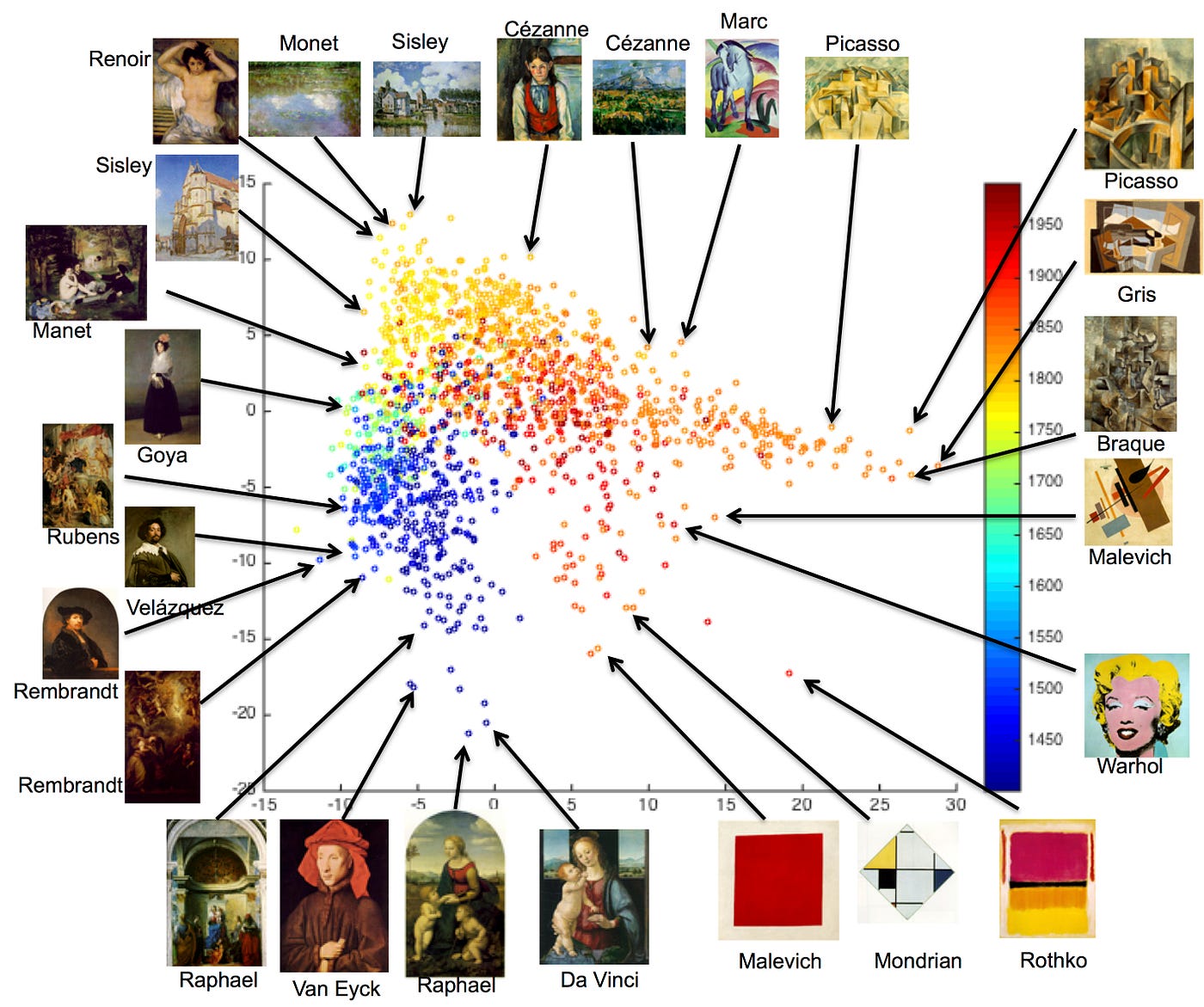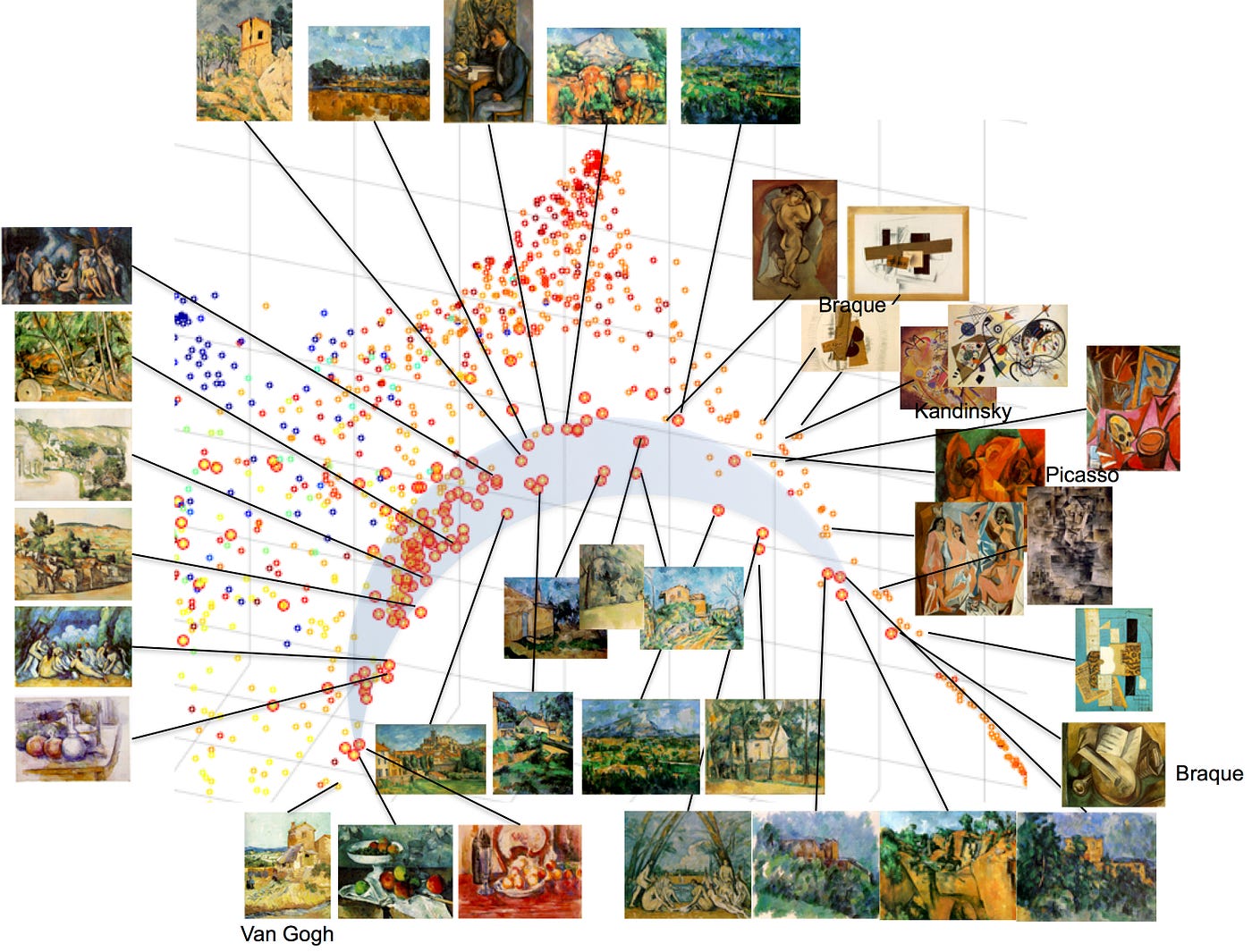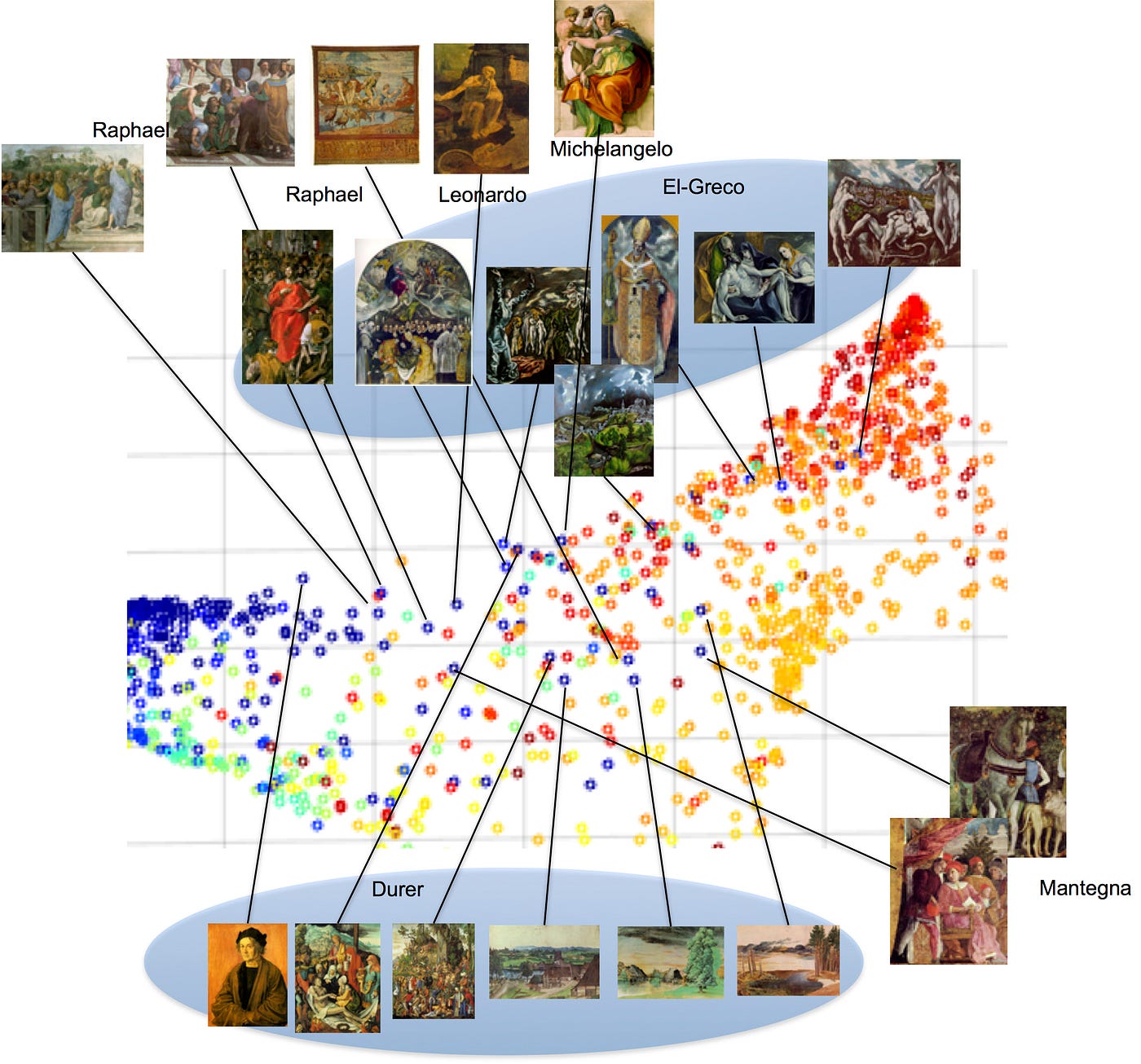The Shape of Art History in the Eyes of the Machine
The Shape of Art History in the Eyes of the Auto
(The blog is co-authored with Professor Marian Mazzone, Fine art History, College of Charleston)

Several studies have shown the power of the motorcar to learn and predict style categories, such as Renaissance, Bizarre, Impressionism, etc., from images of paintings. This implies that the machine can learn an internal representation encoding discriminative features through its visual assay. Nevertheless, such a representation is not necessarily interpretable by humans. How does the machine classify styles in art? And how does it relate to art historian's methods for analyzing style?
At Rutgers' Art and Artificial Intelligence Laboratory, in collaboration with the College of Charleston, we studied this trouble. Our report's emphasis is on agreement how the motorcar achieves classification of style, what internal representation it uses to achieve this task, and how that representation is related to art history methodologies for identifying styles.
To achieve such understanding, we utilized one of the central formulations of way design and manner change in fine art history, the theory of Heinrich Wölfflin (1846–1945). Wölfflin's comparative arroyo to formal assay has become a standard method of art history didactics. Wölfflin chose to split up form analysis from discussions of subject field thing and expression, focusing on the "visual schema" of the works, and how the "visible earth crystallized for the centre in certain forms". Wölfflin identified pairs of works of fine art to demonstrate style differences through comparison and contrast exercises that focused on central principles or features. Wölfflin used his method to differentiate the Renaissance from the Bizarre style through v key visual principles: linear/painterly, planar/recessional, closed form/open grade, multiplicity/unity, absolute clarity/relative clarity. Wölfflin posited that form change has some pattern of differentiation, such that manner types and changes can merely come into existence in certain sequences. Wölfflin'south theory was chosen because of its emphasis on formal, discriminative features and the compare/contrast logic of his system, qualities that get in conducive to motorcar learning. Today, fine art historians use a wide diverseness of methods that are not simply focused on form, but for the blazon of assay of this written report Wölfflin'south approach is useful.
Deep convolutional neural networks have recently played a transformative role in advancing bogus intelligence. We evaluated a large number of land-of-the-art deep convolutional neural network models, and variants of them, trained to classify styles. We focused on increasing the interpretability of the learned presentation by forcing the car to achieve classification with a reduced number of variables without sacrificing nomenclature accuracy. We then analyzed the achieved representations through linear and nonlinear dimensionality reduction of the activation space, visualization, and correlation analysis with time and with Wölfflin's pairs. We used a drove of almost 80K digitized paintings to train, validate and test the models.
One of the principal findings of our report is that the automobile encoded fine art history in a smooth chronology, without being given any notion of time. The machine was trained to predict styles, based just on noisy discrete style labels, with no data provided about when each painting was created, when each style took place, which creative person created which painting, nor how styles are related (such as style ten is similar to manner y, or came subsequently or earlier style z). Despite the lack of all this information, the learned representations are clearly temporally polish and reverberate loftier level of correlation with fourth dimension. For instance, we can run into in the plot to a higher place that the images are bundled in the plot in a radial clock-wise style effectually the middle to brand a complete circumvolve in this 2D projection starting with Renaissance and ending with Abstruse Art. We can come across the progress following the plot in a clock-wise way from Italian and Northern Renaissance at the bottom, to Baroque, to Neo-classicism, Romanticism, reaching to Impressionism at the top followed by Mail service impressionism, Expressionism and Cubism. The loop completes with Abstract and Pop Art.
Some other interesting finding, which explains the closed loop we just saw, is that the learned representation can be explained based on a handful of factors. The start 2 modes of variations are aligned with the concepts of linear vs. painterly and planer vs. recessional suggested by Heinrich Wölfflin, and quantitatively explain near of the variance in art history, where temporal progression correlates radially across these modes. We can clearly see the polish transition from linear class in Renaissance at the bottom towards more painterly grade in Baroque to the farthermost instance of painterly at Impressionism at the acme. And so we tin come across the transition back to linear form in abstruse and Popular art styles. Projecting the information into these two ascendant modes of variations, which are aligned with plane vs. recession and linear vs. painterly, gives an explanation to why this representation correlates with fourth dimension in a radial manner.

Visualizing the different representations shows that certain artists were consistently picked by the motorcar as the distinctive representatives of their styles, every bit they were the extreme points along the dimensions aligned with each mode. This is visible in the first three modes of variations of the representation learned by VGGNet. We can run across the Northern Renaissance in the yellow ellipse with the majority of the paintings sticking out being past Van Eyck and Albrecht Dürer. The Baroque in the blackness ellipse is represented past Rubens, Rembrandt, and Velázquez. The orange ellipse is Impressionism and at its base are Pissarro, Caillebotte, and Manet as the to the lowest degree painterly of the type, catastrophe with Monet and Renoir as most painterly on the end of the spike. The two red circles are Post-Impressionism, and in particular one is dominated past Van Gogh, and the other by Cézanne who forms the base of operations for the spike of Cubism in the light bluish ellipse. This spike is dominated by Picasso, Braque, and Gris; and goes out to the nigh abstruse Cubist works. Most interestingly the representation separates Rousseau, equally marked in the green ellipse, which is mainly dominated by his work.

The learned representations by the motorcar likewise highlighted interesting connections. Most notably, as tin can be seen in Figure Z, Cézanne'southward piece of work acting every bit a bridge between Impressionism at 1 side and Cubism and Abstract at the other side. Art historians consider Cézanne to exist a cardinal figure in the mode transition towards Cubism and the development of abstraction in the 20th century art. This span of Cézanne's painting in the learned representation is quite interesting because that is a quantifiable connection in the information, non merely a metaphorical term. We tin see branching at Post-Impressionism where Cézanne's piece of work conspicuously separates from the other Mail service-Impressionist and expressionist works towards the pinnacle. This branch continues to evolve until information technology connects to early on Cubist works by Picasso and Braque, besides as abstract works by Kandinsky.

Another interesting connection is the link between the Renaissance and mod fine art as captured by the learned representation. Despite the fact that the structure reflects smooth temporal progression, it is interesting to see outlier to this progression. In particular there are some High Renaissance, Northern Renaissance and Mannerist paintings that stick out of the Renaissance cluster to the left and connect to art from belatedly 19th and early 20th centuries. This is considering frequent similarity betwixt art works across time resulted in pulling influential works of art out of order and placing them closer to the art they may have influenced. We can see in the figure that the works that stick out of the Renaissance cluster at the left and connect to modernity are mainly dominated by some paintings past El-Greco and some paintings by Dürer. Among the paintings by El-Greco that significantly stick out are Laocoön, Saint Ildefonso, View of Toledo, and Pietà. Nosotros can as well encounter works by Raphael, Mantegna, and Michelangelo in this group equally well.
The results of this study highlight the potential function that data scientific discipline and machine learning tin can play in the domain of fine art history by approaching art history as a predictive science to discover key patterns and trends non necessarily credible to the individual man center. The study likewise highlights the usefulness of re-visiting the formal methods in art history pioneered past fine art historians such every bit Wölfflin, in the age of data scientific discipline using tools from figurer vision and car learning. Finally, the written report offers insights into the characteristics and functions of style for fine art historians, confirming existing noesis in an empirical style, and providing automobile-produced patterns and connections for further exploration. The results also show that style, which appears to be a subjective effect, can be computationally modeled with objective ways.
The work is published in a paper titled "The Shape of Art History in the Eyes of the Car", which appeared in the 32nd AAAI conference on Artificial Intelligence, held in New Orleans in February 2–7, 2018. The paper can be accessed at https://arxiv.org/abs/1801.07729
Source: https://medium.com/@ahmed_elgammal/the-shape-of-art-history-in-the-eyes-of-the-machine-6c9090257263
0 Response to "The Shape of Art History in the Eyes of the Machine"
Post a Comment